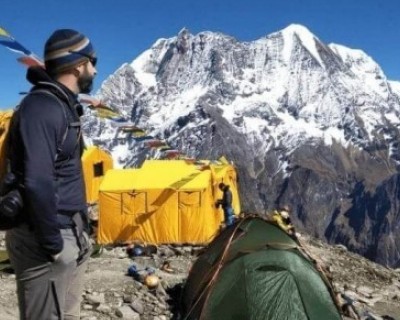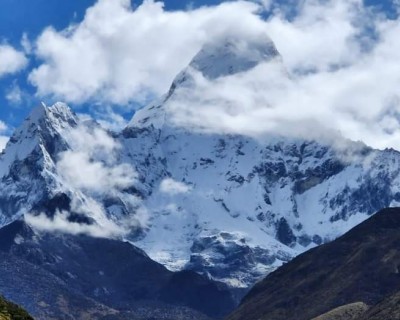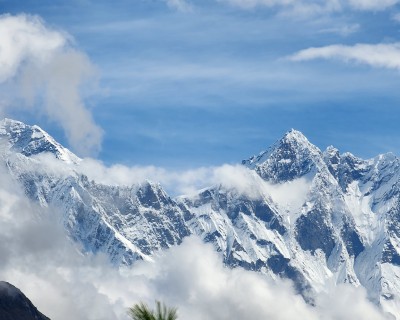So how difficult is it to trek to the Annapurna Base Camp?
Annapurna Base Camp is situated at an altitude of 4130 meters and the route of this trek is one of the most popular and beautiful trekking trails in Nepal after Everest Base camp, it is also very popular for the solo and group trekkers experienced trekkers as well.
Annapurna Base Camp trek is not considered to be a difficult trek because this trek is very adventurous and the key factors of the trek are to walk slow and steadily. So this trek is considered to be a moderate trek. As Everest Base Camp Trek is also a demanding and beautiful trek but with a bit of patience, this trek is very enjoyable and achievable.

Trekking and hiking through the Mountain mean that there may be an adventure waiting for you at every step of your walk. Annapurna Base Camp trek is also a very adventurous and exciting journey for adventure travelers and hikers and the difficulties and the challenges will be added until we reach our destination.
Duration of the Annapurna Base Camp Trek
Annapurna Base Camp Trek usually takes two weeks to complete but if you go rapidly, you can complete this trek within 9 days. The trekking duration can be extended or reduced according to your need and the Annapurna Base Camp trek Itinerary can differ according to different packages made by different travel and trekking agencies.
On the Normal and the average, you have to walk for 5-6 hours a day during your adventure trek to Annapurna Base Camp. If you don't have the habit of walking then you will reach your destination in 7-8 hours which may lead you to problems and grief.
So to avoid this situation and to increase the walking strength you should walk long distance, up and down hills, also set a hiking routine for a few months before you start your adventure hike to Annapurna Base Camp, start exercising by focusing on your legs and your body will get the habit of walking which will help you during your adventure hike more comfortably. You can enjoy this ABC Trek to the fullest.
Total Distance for Annapurna Base Camp Trek
Annapurna Base Camp route covers around 115 Km and you will be walking about 10-15 Km per day. Don't worry it's not a long day hike. If you remembered the statement, the average walking speed of a human is 5 Km per hour. The ABC Trek route is densely populated and usually packed with adventure travelers and hikers from all over the world.
The trekking trail of the Annapurna Base Camp trail is easier, we can enjoy the beautiful Himalayan flora and fauna, however, the rocky terrains of the mountain are a bit difficult and more challenging than the hilly trails. The mountain trail of this trek is rocky and sometimes steep too.
During the winter season, the temperature is below 0°C and the trail of this trekking is covered by snow. It is quite difficult and challenging to make the adventure hike but the trekking trail in these seasons is very popular and busy too.
Types of Trekkers
For the skilled and experienced trekkers and hikers, Annapurna Base Camp trekking trials will not be too difficult. It is a very comfortable, achievable trek for anyone who has the strength to walk on rough terrains for 5-6 hours a day in high-altitude areas.
For the first-time trekkers or hikers in the mountain region, this trek will be a different experience and also it takes more time to cover than the average trekkers cover the distance. As mentioned above, to avoid the difficulties of this trek, it is recommended for you to make up the habit of waking up hills and downhills for a few hours every day. Doing so will increase your walking strength.
If you are a new hiker in the mountain region, it will be very difficult for you to walk in the rocky and steep trails. It would be very good if you hire a porter to enjoy the beautiful moment and a comfortable walk. Porters help you to carry your goods during the adventure hike, walking in high altitude up to the hills and the mountain region with the heavy loads where the oxygen is very thin and lower than in low altitude is not a very good idea.
So to enjoy the trek and have a more comfortable day during the 115 Km distance walking during the trekking trails, hire a porter and experienced Himalayan hikers who are fluent in the language. Hire a guide from a trusted trekking company.

Altitude Sickness
The major problem and the difficulty of trekking to the Mountain region is altitude sickness. The oxygen and the atmospheric pressure at the high altitude are lower than the sea level.
With the thinner level of oxygen and the high altitude, it will take time to adjust to the surrounding environment at such a high altitude. During altitude sickness, you may get the symptoms like nausea, diarrhea, headache, loss of appetite, insomnia, and others.
High altitude can be moderate for some, while for others it can be serious. If you find some symptoms of altitude sickness while making the adventure hike, you should immediately return to a lower altitude region. Do not ignore these types of symptoms which may result in serious problems or the death of the traveler while trekking to the high altitude.
Our adventure trekking starts from the lake city "Pokhara", which is at the altitude of 1400 meters from sea level. You will have to trek up to 4130 meters towards Annapurna Base Camp within a few days.
Hike for a few hours each day at least a month before your actual trek is suggested. This will allow your body to balance with the environment when altitude gradually increases while trekking uphill. Having warm soup and maintaining your diet is also a good way to minimize the risk of altitude sickness.
It is not recommended to drink alcohol at such a high altitude. Though there is some medicine available to prevent altitude sickness, you are suggested to take rest and take precautions than medicine.
Weather and Temperature
Weather and temperature are the major factors that can create a major difficulty in the trekking route as the weather in the mountain region are not constant. It can change drastically and the rise and fall in the temperature are based on the weather, climate, season, and altitude condition.
The Autumn season is the picking season to trek Annapurna Base Camp because of the good and calm weather conditions in the mountain at this time of the year. After Autumn season, the spring season is also the best season to trek in the Annapurna region because the days are very beautiful and charming, we can experience the green and beautiful Himalayan flora and fauna, walk through the green terraced field, with the gorgeous and the heart-touching views of the snow panted mountain peaks.
The best part of trekking in Annapurna Base Camp is you can trek here in the monsoon too as there will be less chance of rainfall in this region. This whole region is rain-shaded, so the monsoon does not affect too much while trekking in the Annapurna region.
The average temperature at the Annapurna Base Camp region is about 15 to 20-degree centigrade on a sunny day during the autumn and spring whereas, in the summer, the temperature ranges from 20-25 degrees centigrade.
Though the days are very beautiful and charming, the winter season is the most dangerous and challenging for the Annapurna Base Camp Trek. In this season, there is the possibility of heavy snowfall and the temperature can be below 0° and can be decreased to minus 17 degrees centigrade at night time. The temperature is normal and moderate during the daytime or under the sun time.
So you should take precautions and pack all the seasonal and essential clothes for the drastic change in the weather and the climate condition.
Lack of Training
Annapurna Base Camp is one of the most legendary, reliable, and classical treks in Nepal as the route of this trek is not steep and difficult. However, for the new mountain hiker, it can be a challenging trail that leads to the base camp of the world's 10th highest iconic snow-capped mountain. So best preparation for the adventure hiking is very essential and important if you are trekking the mountain region for the first time.
Firstly the trekkers should start training for 6 weeks before making the adventure trip to the Annapurna region to make the body healthy, physically and mentally fit, and fine. You should walk almost 5-6 hours a day. If you don't have prior training, you might face several problems catching up with your group or you may even have to quit the adventure trek due to the lack of stamina required and endurance needed to complete the trek.
Downhill trek is easier than uphill trekking. At the higher altitude walk or the walk-in uphill, even a short period of the walk will make you feel tired. Descending towards the lower region is comparatively easier than ascending uphill to the higher altitude as in the high altitude there is very less amount of oxygen up in the mountains.

Joining the mountain trekking training or taking some professional help is very beneficial and recommended. These types of training mainly focus on leg strength, body flexibility, cardio, and stamina.
If you are perfectly trained, you can trek any kind of trekking trail easily. To maintain your fitness, you have to perform difficult works, even simple exercises such as stretching, jogging, swimming, skipping can be helpful for you.
You should be well prepared both physically and mentally. While making the adventure, mental preparedness will provide you alertness. While preparing for the trek, you can use the weight for the hiking exercise which will help you for carrying your backpack during the walk to the Annapurna Base Camp. However, you can also hire a good porter to carry your bag. It is not good to trek at a high altitude without porters because at high altitude your body weight will feel like a burden to carry. With good and the proper training, it is possible to face all the problems and difficulties in Annapurna Base Camp Trek with a smile on the face.
Budget
Nepal is one of the most inexpensive trekking destinations in the world. However, the price of the goods and things you use will get more expensive as you reach a high altitude than at the lower altitude. The cost of the food and accommodation gets tripled or more than it is at the normal rate. This is due to the lack of good transportation and communication facilities in the mountain region.
The only means to transport the good is by yak or mules or porters.
If you want to buy a small bottle of mineral water, it may cost NRS 100 (1 dollar) at a higher altitude. The cost of the other food and accommodation is more expensive in the higher regions than in the lower altitude region.
Although the food and accommodation during the trekking trial are included in the trekking package, if you want to buy some other items, there are ATM facilities in different stations on the ABC Trek route. Though it is the best idea to carry some amount with you.
Luggage, Gear, weight and some other requirement
Packing the bag for about two weeks for a long mountain trek itself is challenging. You should make sure that you are carrying all the necessary items and gear otherwise it may create a problem during the trek. Also, make sure not to carry unnecessary items on the trek by making your bag heavy.
Some essential goods that you should not miss during the adventure hike to Annapurna Base Camp Trek are listed below.
Clothing

The temperature in the mountain area is not always constant. In the early morning, the weather is colder for most of the season, and during sunny days the temperature rises and again in the evening, the temperature falls below 0° centigrade. So you need to wear it in the layer as you can take off the outer layer of the clothes if you feel hot.
- Your clothing should include sweat-absorbent underwear and a shirt, warm clothes that protect you from cold and wind.
- There is a list of the clothing that should be carried on your trek.
- Hiking shirt
- Sweat absorbent/ hiker underwear
- Hiking shocks
- Hiking pants
- Rain protector jacket and trouser
- Lightweight Down Jacket
- Hiking boots
- Warm pairs of gloves
- Hiking sandals
- Sun Hat
- Other Goods
- Trekking Poles
- Sunglasses
- Battery chargers
- Extra Batteries
- Alarm Clock
- Personal water bottle with the iodine tablets
- Camera
- Sleeping bags
- Headlight
- Chocolate or energy bars
- First Aid box with essential medicine for altitude sickness, Diarrhea, cold, nausea, and many other
- Hygiene and toiletries
It is highly recommended that you carry only a small pack of all the needed goods and everyday use items which you need for 2 weeks during trekking. Carrying a big bag may add more burden.
Here are some hygiene and toiletries products.
- Sunscreen
- Soap
- Towel
- Shampoo
- Eye drops
- Lip Balm
- Toilet paper
- Nail Cutter
- Tooth Paste and toothbrush
- Hand Sanitizer
- Moisturizer
- Important documents to be carry at all times during the walk to the Annapurna Base Camp.
- Ensure all these documents will be all-time with you with safe and most secure during the travel in any part of Nepal.
- Passport
- Permits
Enough Cash (you may not get ATM in all parts of Nepal)
It is also recommended not to pack the goods more than 20 Kg whether you carry your own luggage or hire a porter. Avoid carrying unnecessary items like laptops, Ipad, speakers, and other unnecessary heavy clothes.
Choosing the right season for the trekking to the Annapurna region.
Autumn and the spring season is the best time to trek in the Annapurna region. The Autumn season falls from September to November and the spring season falls from March to May. There is a very high chance of rainfall and the weather condition is a little constant and moderate at this time of the year and the skies are usually clear.
This season is a great time of the year to enjoy the religious festival. You will be able to take part in a lot of cultural activities, can enjoy the beautiful and unique cultural programs of the local people.
The trekking in the route of the Annapurna Base Camp is very difficult and challenging due to the heavy snowfall in the high altitude and the way to base camp may be blocked by the snow. The Winter season falls in December, January, and February. These are the coldest months that may affect your health due to the increase of the altitude and decreasing of the temperature.

But if you are a winter person, you can enjoy the winter season in the Himalayan region. The daytime is usually warmer and during the nighttime, the temperature is below 0° so it is good to wrap in a blanket.
June to August is summer and monsoon in Nepal. This season is not considered a good and favorable time to trek in the Annapurna Base Camp but it is little possible to trek in the Annapurna region at the high altitude because this reason is rain shaded area.
Although the weather condition can create some difficulties in the trekking, it is possible to complete the Annapurna Base Camp Trek without any hassle and problems. If you pre-plan for these difficulties properly then you will be able to trek the route to ABC very easily.
It would be best to go for Annapurna Base Camp Trek in pick seasons like October and November or March and April for a better experience of the snow-painted mountain, and the beautiful experience of Himalayan flora and fauna.
Conclusion
If you have a strong will to go for the trekking and explore beautiful Himalayan flora and fauna, the beauty of nature, beautiful adventure, and want to be far from the hustling and the bustling crowd and the busy life of the city then make the adventure trip to Annapurna Base Camp. Annapurna Base Camp Trek is one of the most beautiful and adventurous trekking destinations in Nepal. More than 35000 people make the adventure trip to the Annapurna base camp. Preparedness and walking slow and steady are the key factors needed to face all the difficulties and problems of the trek. Despite all the difficulties, the close view of the world's 10th highest mountain should be motivating enough. The close-up views of some other peaks surrounding Mt Annapurna are Mt Dhaulagiri, Mt Makalu, Mt Nilgiri, Mt Machhapuchhre, and many others.
Feel and make the unforgettable experience and memories of unique and diverse landscapes, culture, and tradition of the people in the adventure trekking route.
Nepal #1 Best Local trekking agency
Nepal Hiking Trek Pvt.Ltd
For more details: [email protected]














